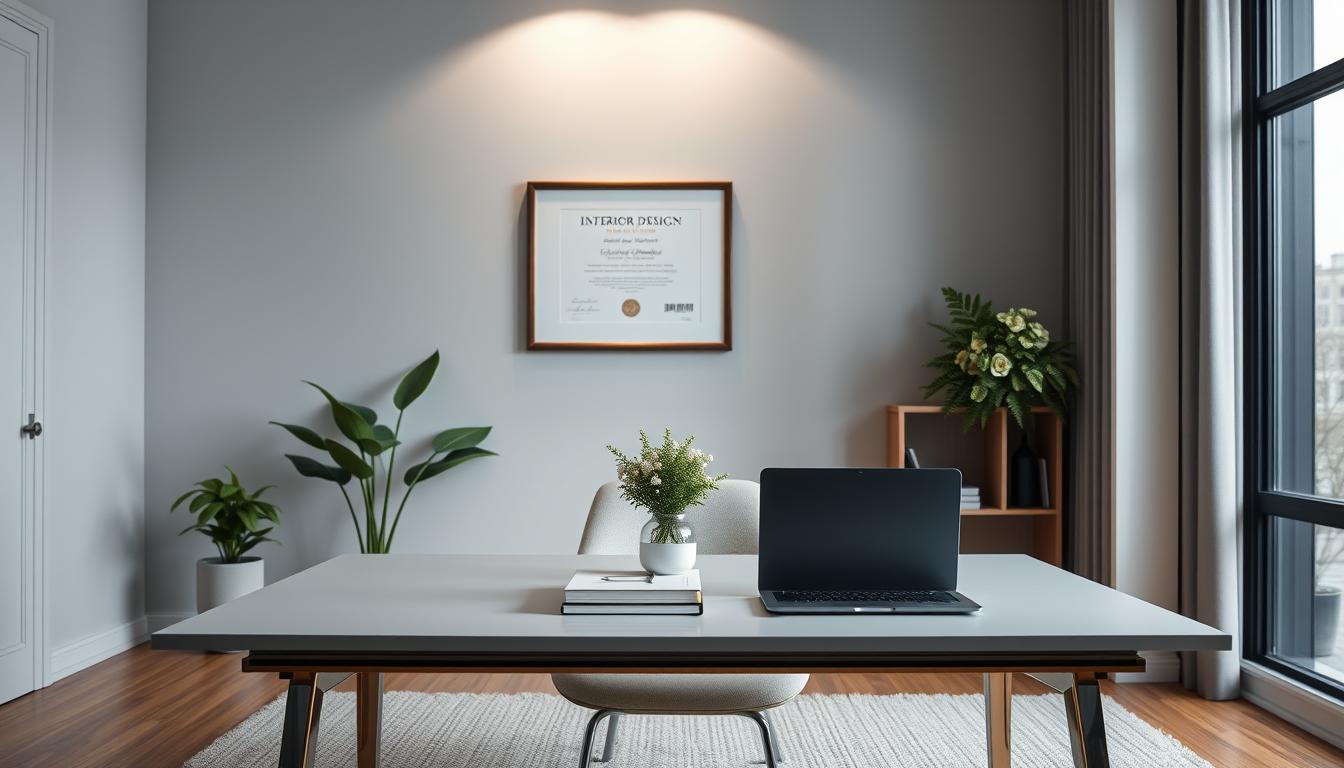Earning an interior design certification can really boost your career. Did you know certified designers make $16,000 more a year? This shows how important a recognized certification is.
To get certified, you need to meet certain education and experience standards. For example, the NCIDQ certification requires 60 semester hours of college and 2-4 years of work experience. You can look into different certifications to take your career to the next level.
Key Takeaways
- Certified interior designers earn higher salaries.
- Specific education and experience are required for certification.
- Various certifications are available, such as NCIDQ.
- Certification can significantly impact career advancement.
- Online certification options are available for flexibility.
Understanding Interior Design Certification
Starting your journey as a certified interior designer means first understanding the certification requirements. It’s key to see how important certification is in this field.
Certification proves your skills and knowledge in interior design. It shows you meet industry standards, making you stand out.
What Is Interior Design Certification?
Interior design certification shows you’re good at your job. You need to finish your education, get some experience, and pass a test. You must also meet the rules set by the certifying group, which often means finishing accredited interior design programs.
These programs teach you the skills and knowledge needed to succeed. By finishing an accredited program, you’re ready for the exam and your future career.
Importance of Certification in the Industry
Certification is key in interior design. It makes sure professionals can do their jobs well. It also builds trust between designers and their clients.
“Certification is a mark of excellence in the interior design industry, demonstrating a commitment to professionalism and staying up-to-date with industry standards.”
Certification has many benefits. It makes you more credible and opens up more job opportunities. Clients and employers like certified designers because they know they’re getting experts.
| Certification Benefits | Description |
|---|---|
| Enhanced Credibility | Certification shows you’re skilled and professional. |
| Increased Career Opportunities | Certified designers are often the first choice for clients and employers. |
| Staying Current with Industry Standards | Certification means you keep learning and follow industry rules. |
Understanding certification requirements and the value of accredited programs is the first step to a great career in interior design.
Types of Interior Design Certifications Available
The interior design world has many certification programs. Each one has its own benefits and special areas of focus. These certifications prove a designer’s skills and knowledge, boosting their career and reputation.
We’ll look at the most well-known certifications in the field. We’ll also cover those from top organizations.
National Council for Interior Design Qualification (NCIDQ)
The NCIDQ certification is highly respected in interior design. It shows a designer has the skills and experience needed for quality work.
The NCIDQ exam has three parts. It tests knowledge in design basics, project management, and professional practices.
Certified Interior Decorators International (C.I.D.)
The C.I.D. certification focuses on the decorative side of interior design. It’s for those who specialize in choosing products, materials, and finishes.
C.I.D. is great for residential designers or those in decorative businesses.
Other Notable Certifications
There are more certifications for interior designers to improve their skills and appeal. These include specializations in sustainable design, universal design, and design technology.
| Certification | Focus Area | Target Professionals |
|---|---|---|
| NCIDQ | Comprehensive interior design knowledge and skills | All interior designers |
| C.I.D. | Decorative aspects of interior design | Residential designers, decorators |
| LEED AP | Sustainable design practices | Designers focusing on green building |
Choosing the right certification depends on a designer’s goals, interests, and local industry needs.
Educational Pathways to Certification
Educational pathways are key for getting ready for interior design certification exams. The right education boosts knowledge and skills. It also raises the chances of passing the exam.
Relevant Degree Programs
Many future interior designers start with degree programs. These programs teach the basics of interior design, including principles and technologies.
- Associate’s Degree: A two-year program that covers the basics of interior design.
- Bachelor’s Degree: A four-year program that goes deeper into design theory, history, and technical skills.
- Master’s Degree: Advanced studies for those aiming to specialize or lead.
| Degree Level | Duration | Key Focus Areas |
|---|---|---|
| Associate’s | 2 Years | Basics of interior design, design principles |
| Bachelor’s | 4 Years | Design theory, history, technical skills |
| Master’s | 2-3 Years | Specialization, leadership, advanced design concepts |
Online Courses and Workshops
Online courses and workshops are great for those looking for interior design certification. They are perfect for:
- Keeping skills up to date with industry standards.
- Getting ready for certification exams.
- Learning specific skills like software use.
Platforms like Coursera, Udemy, and Skillshare have many interior design courses. These courses are made by industry experts. They ensure the learning is current and relevant.
Key Skills for Interior Designers
Aspiring interior designers need a wide range of skills to do well. They must mix creativity with technical know-how and great communication skills.
Creative Design Skills
Creative skills are key for interior designers. They must design spaces that look good and work well. This means knowing about color, space, and picking the right materials.
For example, a designer might need to match a client’s style with a family home’s needs.
Technical Skills and Software Proficiency
Interior designers also need technical skills. They should know how to use software like AutoCAD and SketchUp. These tools help create detailed plans and 3D models.
Knowing building codes and how to find materials is also important. WorkBC says technical skills are crucial for success.
Communication and Project Management Skills
Good communication and project management are vital too. Designers must understand clients’ needs, manage time and money, and work with others. Strong communication ensures projects are done right and on time.
By combining these skills, designers can create great projects and build a strong career. Staying updated with new trends and technologies is key.
Preparing for Certification Exams
Getting certified as an interior designer is a big step. It starts with preparing well for the exams. Knowing the interior design certification requirements is key to success.
First, learn about the exam format and what it covers. These exams test your knowledge and skills. They see if you can use design principles in real situations.
Study Resources and Materials
Choosing the right study materials is crucial. Here are some good options:
- Textbooks and guides made for the NCIDQ exam
- Online courses and workshops on interior design
- Practice exams and quizzes to check your knowledge
Using different study materials can really help. The NCIDQ says, “Candidates who use various study materials do better on the exam.”
“The key to passing the certification exam is not just understanding the concepts, but also being able to apply them in practical scenarios.” –
Tips for Effective Exam Preparation
Good preparation is more than just studying. It’s about planning well. Here are some tips:
- Make a study plan that covers all topics and allows for regular review.
- Join a study group or online community for motivation and learning.
- Practice with sample questions and mock exams to boost your confidence.
Let’s look at a table showing how different study methods affect pass rates:
| Study Method | Pass Rate |
|---|---|
| Textbooks Only | 60% |
| Online Courses Only | 70% |
| Combination of Textbooks and Online Courses | 85% |
By knowing the interior design certification requirements and using the right study materials, you can boost your chances of passing the exams.
Application Process for Certifications
Starting your journey to become a certified interior designer requires clear steps. We’ll walk you through each step. This way, you’ll know what it takes to apply for interior design certifications.
Eligibility Requirements
To get certified, you need education and experience. You must have graduated from accredited interior design programs. These programs are recognized for their quality and curriculum.
The National Association of Schools of Art and Design (NASAD) and the Council for Interior Design Accreditation (CIDA) are key organizations. They accredit interior design programs in the United States.
The rules for eligibility differ by certifying organization. For example, the National Council for Interior Design Qualification (NCIDQ) looks for a degree in interior design or a related field. They also require a certain number of work hours.
| Certifying Organization | Education Requirement | Experience Requirement |
|---|---|---|
| NCIDQ | Degree in Interior Design or related field | Specified number of work hours |
| C.I.D. | Completion of approved interior design courses | Variable, depending on the candidate’s background |
Submission and Documentation Steps
After confirming your eligibility, it’s time to prepare and submit your application. You’ll need to include transcripts from accredited interior design programs, letters of recommendation, and a portfolio of your work.
Start organizing your documents early to avoid delays. Here’s a checklist to help:
- Transcripts from accredited programs
- Letters of recommendation
- Portfolio showcasing your best work
- Proof of work experience
Once you submit your application, it will be reviewed. If approved, you’ll be set to take the certification exam.
Understanding the application process is key for a successful career. By meeting the requirements and preparing well, you’re on your way to becoming a certified professional.
Duration and Costs Involved
It’s important to know how long and how much it costs to get an interior design certification. Prospective candidates need to think about the time and money needed for success.
Timeline for Completing Certification
The time it takes to get certified varies. It depends on the certification type, the candidate’s background, and the certifying organization’s rules. It usually takes a few months to a few years.
For example, getting ready for the NCIDQ exam can take 6 to 12 months. This is if the candidate has met the needed requirements. Getting eligible can take 2 to 4 years, depending on the degree or work experience needed.
Breakdown of Costs
The costs for interior design certification can be high. They include:
- Tuition fees for educational programs or courses.
- Study materials like textbooks, online courses, and practice exams.
- Examination fees, which change based on the certifying body and exam.
- Membership fees for professional organizations, often required or recommended.
- Costs for continuing education or professional development.
The NCIDQ certification can cost between $1,000 and $2,000. This includes exam fees and study materials. Other certifications, like those from Certified Interior Decorators International (C.I.D.), have different costs.
Some employers might pay for certification costs or support continuing education. It’s good for candidates to look into these options for their career plan.
In summary, getting an interior design certification takes time and money. But, it’s an investment in a professional’s future. Understanding these aspects helps candidates plan their certification journey.
Maintaining Certification
Certified interior designers must keep up with continuing education to keep their certification. This ensures they know the latest in the field. They stay current with standards, technologies, and design principles.
Continuing Education Requirements
To keep their certification, interior designers must complete a set number of continuing education hours. These hours can be earned through workshops, seminars, and conferences. They can also be earned online through interior design certification online courses. The exact number of hours needed varies by certifying organization.
For example, the National Council for Interior Design Qualification (NCIDQ) asks for 75 hours of continuing education every 5 years. This can include:
- Attending industry conferences
- Participating in workshops
- Completing online courses
- Engaging in professional development activities
Recertification Process
The recertification process requires more than just continuing education hours. It also means following the certifying organization’s rules and deadlines. It’s crucial for certified professionals to know the recertification rules and plan ahead to keep their certification.
Here’s a hypothetical example of a recertification timeline:
| Year | Continuing Education Hours Required | Recertification Deadline |
|---|---|---|
| 1-2 | 20 hours | December 31, Year 2 |
| 3-5 | 40 hours | December 31, Year 5 |
By meeting the continuing education needs and following the recertification steps, interior designers can keep their certification. This shows their ongoing commitment and expertise in the field.
Career Opportunities with Certification
Getting an interior design certification can really boost your career. It shows you’re an expert and opens more doors in the field.

Job Titles and Roles
Certified interior designers have many job options. They can be:
- Residential Interior Designer
- Commercial Interior Designer
- Design Director
- Space Planner
- Design Consultant
These jobs are in design firms, architectural companies, and furniture makers. You can also find them in retail companies’ design teams. For more details, check out our guide at Cozy Nest Plans.
Salary Expectations
The pay for certified interior designers varies. It depends on where you work, how long you’ve been doing it, and your job. But, being certified usually means you can earn more.
Reports say certified designers can make between $40,000 and over $100,000 a year. This depends on your area of focus and experience.
What affects your salary includes:
- Where you live
- How long you’ve been working
- Who you work for
- What your job is
Getting certified can improve your career and pay. It’s a smart move for your future in interior design.
Conclusion: The Value of Certification
Getting an interior design certification is a big step in a designer’s career. It brings many benefits that boost their professional standing and job chances. This certification shows designers’ skills and dedication, making them stand out in a tough field.
Professional Growth
Certification proves a designer’s skills and knowledge, boosting their credibility. This trust is key to getting more clients and job offers, helping them move up in their career.
Career Advancement
With a design certification, designers can get better jobs and work on more important projects. This opens up new chances for growth and helps them reach their career dreams.
We’ve looked at the different parts of interior design certification. This includes the types of certifications, how to apply, and the career chances it offers. By getting this certification, designers can greatly improve their professional standing and find new job opportunities.



